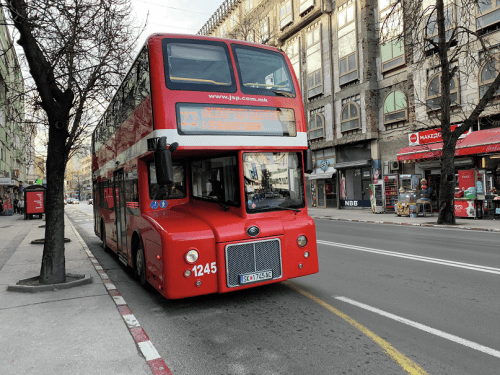
In last week’s issue, Jonathan Welch looked at Yutong’s UK electric bus offering. Now he turns his attention to one of its more unusual products, the City Master
Although the Yutong name has become familiar over the last few years in the UK, enthusiasts here may well have seen another of the manufacturer’s products without realising it. According to its website, the manufacturer only has one double-deck bus in its current line-up, the ZK6116HGS, a conventional 11.3-metre long, 4.2-metre tall two-door diesel bus. However, in 2010 Yutong developed its City Master low-floor double-decker which was designed as a bespoke vehicle for municipal operator JSP in Skopje in the Republic of Macedonia.
Based on its standard ZK6116HGS, the CIty Master was designed in retro style to resemble London’s Routemaster. Ordered in April 2010 at a reported cost of €35.5m, the first 68 of the initial order of 202 buses (including two with open tops for tourist services) entered service from September 2011. The order was later increased to 217 (not 220 as reported by some online sources) by the addition of an extra 15 convertible open-top versions with removable roofs for tourist routes.
One online source suggests a cost of €175,000 per bus, whilst the total cost of the project was reported elsewhere as slightly higher at €42 million. The buses were paid by the Macedonian government; as in London with its ‘New Routemasters,’ local opponents suggested that the money could have been better spent, especially as large numbers of trees in the city needed trimming to accommodate the new buses.
The buses were delivered in a London/NBC-esque red with white band above the lower windows, though many seem to have quickly lost this on the sides. Many carry vinyl advertising panels between the upper and lower deck windows or full side advertisements. Earlier deliveries had a red LED front destination display, though later higher-numbered vehicles reverted to the more usual orange. The buses are fitted with two staircases, one behind the cab opposite the front door, and the other on the nearside forward of the rear door. The cab itself is tapered and offers much more space than a traditional half-cab. It widens towards the rear, and is accessed tram-style through a door into the saloon. When visiting in 2016, blogger Marc C, writer of transport blog Prochain arret! (online at nachster-halte.blogspot.com), noted that whilst the doors feature cash trays to allow on-bus payments, drivers tended to leave them open to make taking fares easier. For passengers, who can choose to pay on board or buy cheaper tickets off-bus before they travel, there are 18 thinly-padded seats on the lower deck, along with three tip-up seats near the front door and standing space for 20. The upper deck offers further seating for 39.

By subscribing you will benefit from:
- Operator & Supplier Profiles
- Face-to-Face Interviews
- Lastest News
- Test Drives and Reviews
- Legal Updates
- Route Focus
- Industry Insider Opinions
- Passenger Perspective
- Vehicle Launches
- and much more!


